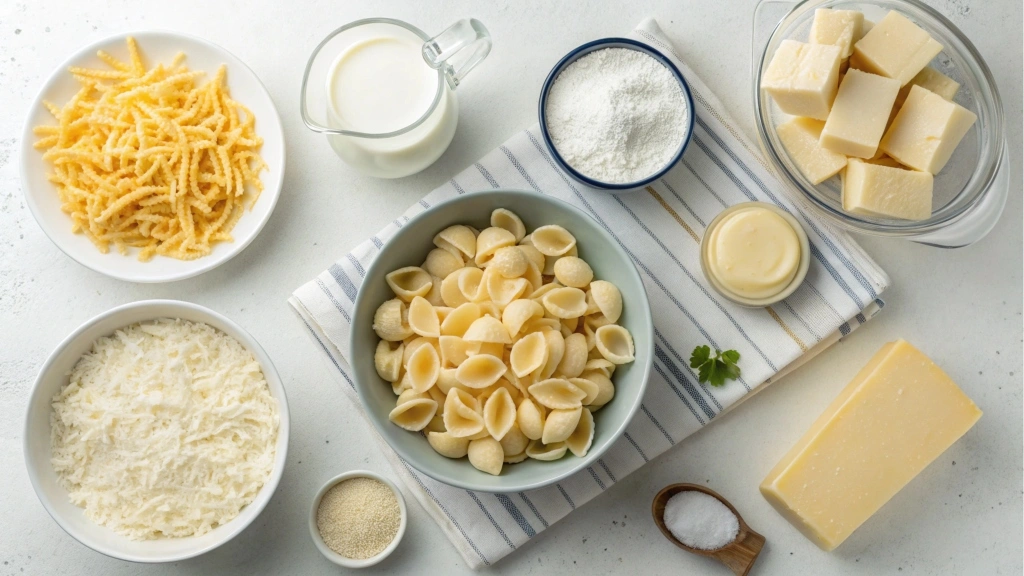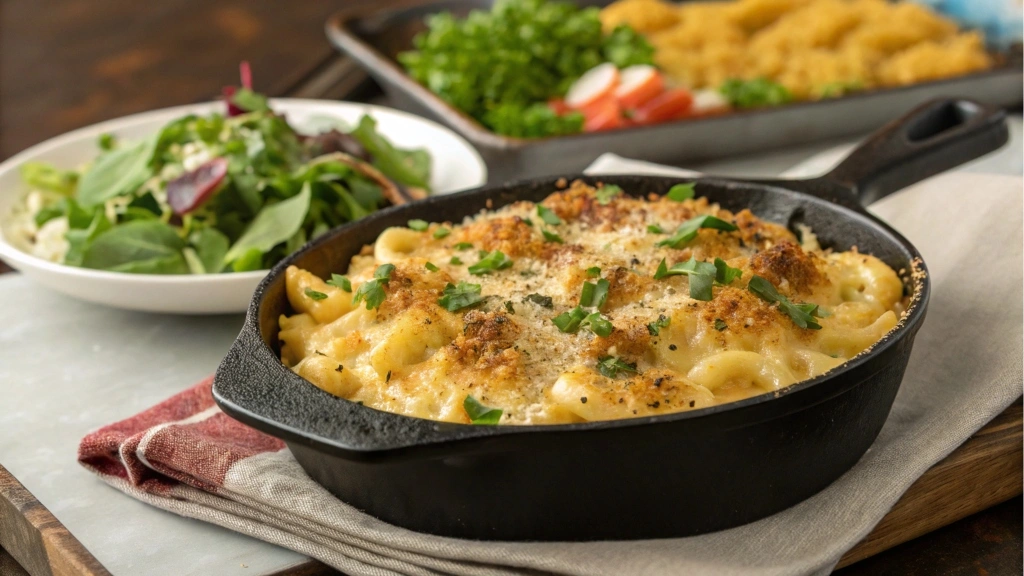When it comes to comfort food, few dishes can compete with the creamy, cheesy delight of shells and cheese. It’s the ultimate cozy meal, perfect for a family dinner, a solo indulgence, or even a party side dish. The combination of tender pasta shells enveloped in a rich, velvety cheese sauce is nothing short of culinary perfection. This recipe brings the magic of shells and cheese right to your kitchen, with step-by-step guidance to ensure mouthwatering results every time.
In this article, you’ll learn how to make a classic shells and cheese dish from scratch, with tips for customization, serving, and even dietary alternatives. Whether you’re a beginner or a seasoned cook, this guide will help you achieve a dish so delicious, you’ll want to make it again and again.
Let’s dive into the ingredients, tools, and techniques to create your new favorite comfort food. Ready to cook? Let’s go!
Ingredients You’ll Need
To create the ultimate shells and cheese, you’ll need a mix of pantry staples and fresh ingredients. Here’s a breakdown of what to gather:

Main Ingredients for the Recipe
- Pasta Shells (12 ounces): Medium-sized shells work best because their shape holds the cheese sauce perfectly.
- Butter (4 tablespoons): Adds richness to the sauce.
- All-Purpose Flour (3 tablespoons): The key to thickening the cheese sauce.
- Milk (3 cups): Whole milk is ideal for creaminess, but you can use 2% if preferred.
- Heavy Cream (1/2 cup): Adds extra silkiness to the sauce.
- Cheddar Cheese (2 cups, shredded): Sharp cheddar gives a bold, cheesy flavor.
- Mozzarella Cheese (1 cup, shredded): For a gooey texture.
- Parmesan Cheese (1/2 cup, grated): Provides a tangy, savory edge.
- Salt and Pepper: To taste.
- Paprika or Cayenne Pepper (optional): A pinch for a subtle kick.
Optional Add-Ons for a Twist
- Cooked Bacon Bits: Adds a smoky, salty crunch.
- Shredded Chicken: Turns it into a hearty main dish.
- Steamed Broccoli: Balances the richness with a pop of green.
- Breadcrumbs: Toasted and sprinkled on top for texture.
Kitchen Tools Required
Having the right tools can make all the difference when preparing this dish. Here’s what you’ll need:
Essential Utensils for Perfect Results
- Large Pot: For boiling the pasta.
- Colander: To drain the cooked shells.
- Medium Saucepan: For making the cheese sauce.
- Whisk: Ensures a smooth, lump-free sauce.
- Wooden Spoon or Silicone Spatula: For mixing the pasta and sauce.
- Measuring Cups and Spoons: To measure out ingredients precisely.
Tips for an Easy Clean-Up
- Use nonstick cookware for the cheese sauce to prevent sticking and burning.
- Line your counter with parchment paper to catch spills when grating cheese or measuring flour.
With your ingredients prepped and tools ready, it’s time to dive into the heart of the recipe: cooking the pasta and crafting the creamy cheese sauce.
Step-by-Step Instructions
Making shells and cheese from scratch is easier than you might think. Follow these steps to create a creamy, comforting dish that’s sure to impress.
Preparing the Pasta: Cooking Shells to Perfection
- Boil Water: Fill a large pot with water, add a generous pinch of salt, and bring it to a rolling boil. Salting the water helps flavor the pasta.
- Cook the Shells: Add the pasta shells and stir occasionally to prevent sticking. Cook them 1-2 minutes less than the package instructions for al dente texture, as they’ll cook further when mixed with the cheese sauce.
- Drain the Pasta: Once the shells are tender but firm, drain them using a colander. Set aside and drizzle a teaspoon of olive oil over them to keep them from clumping.
Making the Cheese Sauce: The Secret to Creaminess
The cheese sauce is the star of this dish. Here’s how to achieve that smooth, creamy texture:
Create a Roux
- Melt the Butter: In a medium saucepan, melt the butter over medium heat until it begins to bubble gently.
- Add the Flour: Sprinkle in the flour and whisk continuously for about 2 minutes. This step removes the raw taste of the flour and forms the base of your sauce.
Add the Milk and Cream
- Gradually Pour in Milk: Slowly pour in the milk while whisking constantly. This prevents lumps from forming. Add the heavy cream as well.
- Simmer: Reduce the heat to medium-low and let the mixture simmer for about 5 minutes, whisking occasionally, until it thickens slightly and coats the back of a spoon.
Melt the Cheese
- Add Cheeses Gradually: Lower the heat and stir in the shredded cheddar, mozzarella, and grated Parmesan, one handful at a time. Whisk until each addition melts fully before adding the next.
- Season: Add a pinch of salt, black pepper, and paprika or cayenne (if using) to taste. Adjust the seasoning based on your preference.
Combining Shells and Sauce
- Combine Pasta and Sauce: Once the cheese sauce is smooth and creamy, add the cooked pasta shells to the saucepan. Stir gently to ensure every shell is coated with the cheesy goodness.
- Heat Through: Allow the mixture to warm for 2-3 minutes over low heat, stirring occasionally. This helps the flavors meld together.
Variations of Shells and Cheese
Classic shells and cheese is delightful on its own, but adding a personal twist can elevate the dish to a whole new level. Here are some creative ideas to customize your recipe.
Adding Protein: Make It a Meal
- Shredded Chicken: Mix in 1-2 cups of cooked, shredded chicken for a heartier dish. Rotisserie chicken works perfectly for this.
- Crispy Bacon: Sprinkle crumbled bacon into the cheese sauce or on top for a smoky, salty crunch.
- Ground Beef or Sausage: Brown and season ground beef or sausage, then stir it into the pasta for a meaty variation.
Vegetable Add-Ins: Boost the Nutrition
- Broccoli Florets: Steam or blanch broccoli and fold it into the dish for a vibrant, healthy addition.
- Peas: Sweet green peas complement the rich cheese sauce and add a pop of color.
- Spinach: Stir in a handful of fresh baby spinach while the pasta and sauce are still warm; it wilts beautifully into the dish.
- Roasted Vegetables: Add roasted bell peppers, zucchini, or cherry tomatoes for a touch of smoky, caramelized flavor.
Enhancing the Texture: Toppings and Mix-Ins
- Toasted Breadcrumbs: Combine panko breadcrumbs with melted butter and sprinkle them over the top. Broil the dish briefly for a crunchy topping.
- Crumbled Crackers: Use crushed buttery crackers or cheese-flavored chips for a unique, savory crust.
- Extra Cheese Layer: Sprinkle more shredded cheese on top and bake until bubbly and golden brown.
Spice It Up: Add Bold Flavors
- Jalapeños: Add diced fresh or pickled jalapeños for a kick of heat.
- Spicy Sausage: Swap in chorizo or spicy Italian sausage for a bold, flavorful variation.
- Buffalo Sauce: Drizzle buffalo sauce over the finished dish for a tangy, spicy twist.
International Twists: Explore New Flavors
- Mexican-Inspired: Add taco seasoning to the cheese sauce and mix in black beans, corn, and diced tomatoes. Top with a dollop of sour cream and cilantro.
- Italian Style: Use a blend of mozzarella, Parmesan, and ricotta, then stir in marinara sauce for an Italian spin.
- French Gourmet: Mix in a touch of Dijon mustard and use Gruyère cheese for a luxurious French-inspired version.
Vegan and Gluten-Free Alternatives
If you’re looking to accommodate dietary preferences or restrictions, don’t worry shells and cheese can still be a part of the menu! Here’s how to adapt the recipe for vegan and gluten-free lifestyles without sacrificing flavor.
Vegan Shells and Cheese
Creating a creamy, cheesy vegan version might sound challenging, but with the right ingredients, it’s a breeze.
Ingredients for Vegan Cheese Sauce
- Plant-Based Milk (2 ½ cups): Use unsweetened almond, oat, or soy milk for a neutral flavor.
- Nutritional Yeast (1/4 cup): Provides a cheesy, nutty flavor.
- Cashews (1 cup, soaked): When blended, soaked cashews create a creamy texture.
- Carrots (1 small, peeled and boiled): Adds color and subtle sweetness to the sauce.
- Potato (1 small, peeled and boiled): Helps thicken the sauce naturally.
- Garlic Powder (1 teaspoon): Adds depth to the flavor.
- Dijon Mustard (1 teaspoon): Enhances the tangy cheese-like taste.
- Paprika or Smoked Paprika (optional): For a hint of spice and smokiness.
- Salt and Pepper: To taste.
Steps for Vegan Cheese Sauce
- Boil the Vegetables: Cook the carrot and potato until soft, about 10 minutes.
- Blend Ingredients: In a blender, combine the boiled vegetables, soaked cashews, plant-based milk, nutritional yeast, garlic powder, mustard, and seasonings. Blend until smooth.
- Heat the Sauce: Transfer the sauce to a saucepan and warm over low heat, stirring occasionally.
Pasta
- Use egg-free pasta shells to ensure the dish is 100% vegan.
Gluten-Free Shells and Cheese
For a gluten-free option, the substitutions are simple and effective.
Ingredients for Gluten-Free Shells and Cheese
- Gluten-Free Pasta Shells: Choose your favorite brand of gluten-free pasta.
- Gluten-Free Flour: Use a 1:1 gluten-free flour blend to make the roux.
- Cheese Sauce Adjustments: Stick to the classic cheese options like cheddar and mozzarella, which are naturally gluten-free.
Steps for Gluten-Free Cheese Sauce
- Make the Roux: Follow the same process as the traditional recipe, using gluten-free flour in place of all-purpose flour.
- Combine: Add the gluten-free pasta to the sauce and stir to coat evenly.
Combining Both: Vegan and Gluten-Free
For a dish that’s both vegan and gluten-free:
- Use vegan cheese sauce (as described above).
- Pair it with gluten-free, egg-free pasta shells.
Tips for Serving and Presentation
Presentation is the finishing touch that elevates your shells and cheese from a humble dish to a culinary masterpiece. Whether you’re serving it at a family dinner or showcasing it at a gathering, these tips will ensure your dish is as visually appealing as it is delicious.
Plating Ideas for a Cozy Meal
- Individual Servings: Use small ramekins or mini casserole dishes to serve individual portions. This adds a touch of elegance and makes serving easier.
- Family-Style Dish: Serve the shells and cheese in a large, shallow serving dish, garnished for added appeal.
- Garnished Bowl: Place the dish in a deep bowl and top it with colorful garnishes for a rustic, hearty look.
Garnish Options for Added Flavor and Appeal
- Fresh Herbs: Sprinkle chopped parsley, chives, or basil over the dish for a pop of color and freshness.
- Crumbled Toppings: Add toasted breadcrumbs, crushed crackers, or crispy bacon bits for a crunchy texture.
- Spices: Dust the top with a pinch of smoked paprika, cayenne, or black pepper for visual appeal and flavor.
- Cheese Drizzle: Melt extra cheese and drizzle it over the top for a decadent finishing touch.
Creative Serving Vessels
- Bread Bowl: Hollow out a round loaf of bread and serve the shells and cheese inside for a fun, edible serving dish.
- Skillet: Present the dish in a cast-iron skillet straight from the oven for a rustic, homestyle vibe.
- Colorful Plates: Use brightly colored or patterned dishes to contrast with the creamy yellow-orange hue of the shells and cheese.
Pairing Suggestions
To create a balanced meal, serve shells and cheese with complementary sides and beverages:
- Sides:
- A fresh green salad with a tangy vinaigrette.
- Roasted vegetables like asparagus or Brussels sprouts.
- Warm garlic bread for dipping into the cheese sauce.
- Drinks:
- A crisp white wine or a light beer to cut through the richness.
- Lemon-infused water or iced tea for a refreshing, non-alcoholic option.
Storing and Reheating
Shells and cheese are just as enjoyable the next day if not more so when stored and reheated properly. Follow these tips to preserve its creamy texture and delicious flavor.
Best Practices for Storing Leftovers
- Cool Completely: Allow the shells and cheese to cool to room temperature before storing. This prevents condensation, which can lead to sogginess.
- Use Airtight Containers: Transfer leftovers to an airtight container to maintain freshness and prevent the dish from absorbing odors in the fridge.
- Refrigeration: Store in the refrigerator for up to 3-4 days.
- Freezing Option:
- For longer storage, freeze the shells and cheese in a freezer-safe container.
- Before freezing, consider portioning into single servings for easy reheating.
- Label the container with the date; it’s best to use within 2 months.
Reheating Without Losing Texture
- On the Stove:
- Place the shells and cheese in a saucepan over low heat.
- Add a splash of milk or cream to loosen the sauce and stir frequently to prevent sticking.
- Heat until warmed through, about 5-7 minutes.
- In the Oven:
- Preheat the oven to 350°F (175°C).
- Transfer the shells and cheese to an oven-safe dish.
- Cover with foil to retain moisture and bake for 15-20 minutes.
- Remove the foil in the last 5 minutes for a slightly crispy top.
- In the Microwave:
- Place a portion in a microwave-safe dish.
- Add a small splash of milk, cover with a microwave-safe lid or damp paper towel, and heat on medium power in 1-minute intervals, stirring in between, until warm.
Freezer-to-Table Tips
- Thaw frozen shells and cheese in the refrigerator overnight before reheating.
- If reheating from frozen, bake at 375°F (190°C) for 30-40 minutes, covered, until heated through. Stir occasionally to ensure even warming.
FAQs About Shells and Cheese
Even the simplest comfort foods come with their share of questions. Here are some frequently asked questions to help you perfect your shells and cheese experience.
1. Can I Freeze Shells and Cheese?
Yes, you can freeze shells and cheese! Follow these steps for the best results:
- Cool the dish completely before freezing.
- Transfer to a freezer-safe container or resealable bag, removing as much air as possible.
- Freeze for up to 2 months.
- Thaw in the refrigerator overnight before reheating for the best texture.
2. What’s the Best Cheese Combination for Shells and Cheese?
The ideal cheese combination depends on your taste preferences. Here are some popular options:
- Classic Blend: Sharp cheddar, mozzarella, and Parmesan.
- Gooey and Mild: Monterey Jack, mild cheddar, and cream cheese.
- Bold and Gourmet: Gruyère, fontina, and a touch of blue cheese.
3. How Do I Keep the Cheese Sauce Creamy?
A creamy sauce depends on proper technique:
- Use full-fat milk and cream for richness.
- Avoid overheating the cheese sauce to prevent separation.
- Add cheese gradually to the roux, stirring constantly for a smooth texture.
4. Can I Make Shells and Cheese Ahead of Time?
Absolutely! You can prepare the dish in advance:
- Cook the pasta and make the cheese sauce.
- Combine and transfer to a baking dish.
- Cover tightly with foil and refrigerate for up to 24 hours.
- When ready to serve, bake at 350°F (175°C) for 20-25 minutes until heated through.
5. What Are Some Healthy Additions for Shells and Cheese?
Balance the richness of shells and cheese with healthy ingredients like:
- Steamed or roasted broccoli.
- Sautéed mushrooms.
- Diced tomatoes or sun-dried tomatoes.
- Grilled chicken or turkey sausage for lean protein.
6. Why Is My Cheese Sauce Grainy or Lumpy?
Grainy or lumpy sauce typically results from:
- Overheating the cheese, causing it to separate.
- Adding cheese to a boiling sauce instead of a simmering one.
- Using pre-shredded cheese, which often contains anti-caking agents that can affect the sauce’s texture.
To fix this, strain the sauce through a fine mesh sieve and return it to low heat while whisking vigorously.
Conclusion
Shells and cheese is more than just a dish it’s a warm hug in a bowl. Whether you stick to the classic recipe or explore the exciting variations, this comfort food never fails to bring joy to the table. From the tender pasta shells that cradle the velvety cheese sauce to the endless customization options, this recipe is as versatile as it is delicious.
With our step-by-step guide, you’ve learned how to craft a creamy cheese sauce, select the perfect add-ins, and even adapt the recipe for vegan or gluten-free diets. Plus, with tips for storage, reheating, and serving, you’re equipped to make this dish ahead of time or savor every bite as leftovers.
So, the next time you crave something cozy, why not whip up a batch of shells and cheese? It’s a guaranteed crowd-pleaser, whether you’re cooking for loved ones or indulging in some well-deserved self-care.
Explore ideas to pair with this creamy shells and cheese, such as our “Steamed Spinach” or a side of “Bang Bang Chicken”. Let your culinary creativity shine!

